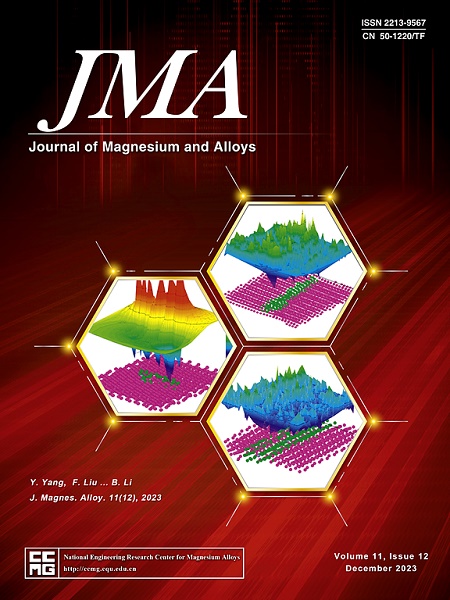层状mos2负载和金属ni掺杂MgH2增强储氢动力学和循环稳定性
IF 13.8
1区 材料科学
Q1 METALLURGY & METALLURGICAL ENGINEERING
引用次数: 0
摘要
镁基储氢材料因其含氢量高、资源丰富、环境友好等优点而备受关注。但脱氢温度高、动力学慢、循环稳定性差,限制了其实际应用。本研究证明了金属Ni和层状MoS2(简称“Ni-MoS2”)的混合改性MgH2脱氢动力学和循环稳定性的改善,其中Ni作为MgH2的催化剂,MoS2作为Ni和MgH2的载体。MgH2的起始脱氢温度降至198℃,在50℃的低温下开始加氢。MgH2 + 10 wt % Ni-MoS2复合材料具有快速脱氢动力学,在300℃的恒定温度下,10 min内可脱氢6.1 wt %,脱氢活化能从151降低到85 kJ mol−1。在循环过程中,复合材料的可逆容量在前22次循环中首先呈现出逐渐增加的趋势,在第23次循环至第50次循环中保持在6.1 wt %。理论计算表明,Ni/MoS2的加入不会改变MgH2的整体热力学性质,但会削弱局部区域的Mg-H键。微观结构研究表明,金属Ni与MgH2反应生成Mg2NiH0.3, Mg2NiH0.3可以作为氢泵,而层状MoS2则为MgH2和Ni的良好分散提供了支撑。研究认为,Mg2NiH0.3和层状MoS2的协同作用是MgH2储氢能力显著增强的原因。这项工作为通过简单的球磨引入过渡金属和层状材料的组合来增强镁基储氢材料提供了一种有前途和简单的策略。本文章由计算机程序翻译,如有差异,请以英文原文为准。
Layered MoS2-supported and metallic Ni-doped MgH2 towards enhanced hydrogen storage kinetics and cycling stability
Mg-based hydrogen storage materials have attracted much attention due to their high hydrogen content, abundant resources, and environmental friendliness. However, the high dehydrogenation temperature, slow kinetics and poor cycling stability are limiting its practical application. This work demonstrates the improved dehydrogenation kinetics and cycling stability of MgH2 modified by a hybrid of metallic Ni and layered MoS2 (denoted as “Ni-MoS2 ”) introduced by ball milling, with Ni as the catalyst for MgH2 and MoS2 as the support for both Ni and MgH2 . The onset dehydrogenation temperature of MgH2 is reduced to 198 °C, and the rehydrogenation begins at a low temperature of 50 °C. The MgH2 + 10 wt % Ni-MoS2 composite has a fast dehydrogenation kinetics and can release 6.1 wt % hydrogen in 10 min at a constant temperature of 300 °C, with the dehydrogenation activation energy significantly reduced from 151 to 85 kJ mol−1 . During the cycling, the reversible capacity of the composite first exhibits a gradual increase for the initial 22 cycles and then maintains at 6.1 wt % from the 23th cycle to the 50th cycle. The Ni/MoS2 addition does not change the overall thermodynamic properties of MgH2 but can weaken the Mg–H bonds in the local regions as evident by theoretical calculation. Microstructure studies reveal that the metallic Ni will react with MgH2 to form Mg2 NiH0.3 , which can act as a hydrogen pump, while the layered MoS2 serves as a support for the well dispersion of MgH2 and Ni. It is believed that the synergy of Mg2 NiH0.3 and layered MoS2 contributes to the significantly enhanced hydrogen storage of MgH2 . This work provides a promising and simple strategy for enhancing the Mg-based hydrogen storage materials by combination of transition metals and layered materials introduced via simple ball milling.
求助全文
通过发布文献求助,成功后即可免费获取论文全文。
去求助
来源期刊

Journal of Magnesium and Alloys
Engineering-Mechanics of Materials
CiteScore
20.20
自引率
14.80%
发文量
52
审稿时长
59 days
期刊介绍:
The Journal of Magnesium and Alloys serves as a global platform for both theoretical and experimental studies in magnesium science and engineering. It welcomes submissions investigating various scientific and engineering factors impacting the metallurgy, processing, microstructure, properties, and applications of magnesium and alloys. The journal covers all aspects of magnesium and alloy research, including raw materials, alloy casting, extrusion and deformation, corrosion and surface treatment, joining and machining, simulation and modeling, microstructure evolution and mechanical properties, new alloy development, magnesium-based composites, bio-materials and energy materials, applications, and recycling.
 求助内容:
求助内容: 应助结果提醒方式:
应助结果提醒方式:


